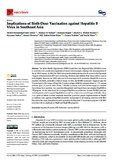| dc.contributor.author | Fazle Akbar, Sheikh Mohammad | |
| dc.contributor.author | Al Mahtab, Mamun | |
| dc.contributor.author | Begum, Ferdousi | |
| dc.contributor.author | Hossain, Shaikh A. Shahed | |
| dc.contributor.author | Sarker, Sukumar | |
| dc.contributor.author | Shrestha, Ananta | |
| dc.contributor.author | Khan, Md. Sakirul Islam | |
| dc.contributor.author | Yoshida, Osamu | |
| dc.contributor.author | Hiasa, Yoichi | |
| dc.date.accessioned | 2022-06-29T06:29:16Z | |
| dc.date.available | 2022-06-29T06:29:16Z | |
| dc.date.copyright | 2021 | |
| dc.date.issued | 2021-04-12 | |
| dc.identifier.citation | Akbar, S. M. F., Al Mahtab, M., Begum, F., Hossain, S. A. S., Sarker, S., Shrestha, A., . . . Hiasa, Y. (2021). Implications of birth-dose vaccination against hepatitis B virus in Southeast Asia. Vaccines, 9(4) doi:10.3390/vaccines9040374 | en_US |
| dc.identifier.uri | http://hdl.handle.net/10361/17013 | |
| dc.description | This article was published in the Vaccines by MDPI [© 2021 by the authors. Licensee MDPI, Basel, Switzerland. This article is an open access article distributed under the terms and conditions of the Creative Commons Attribution (CC BY) license (https:// creativecommons.org/licenses/by/ 4.0/).] and the definite version is available at: https://doi.org/10.3390/vaccines9040374 The Journal's website is at: https://www.mdpi.com/2076-393X/9/4/374 | en_US |
| dc.description.abstract | The World Health Organization (WHO) South-East Asia Regional Office (SEARO) covers
11 countries with a combined population of about 2 billion people, making it the most populous of
the six WHO regions. In 1992, the WHO advocated including the hepatitis B vaccine in the Expanded
Program of Immunization (EPI) and vaccinating all infants and children three times within 1 year of
birth (HepB3). Recently, the WHO advocate birth-dose hepatitis B vaccination (HepB-BD) as soon as
possible after birth, preferably within 24 hours. In 2016, the SEARO endorsed a regional hepatitis
B control goal with a target of hepatitis B surface antigen (HBsAg) seroprevalence of ≤1% among
children aged ≥5 years by 2020. Of the 11 SEARO countries, four achieved this target on schedule.
Out of these four countries, two countries (Bangladesh and Nepal) have not adopted HepB-BD in
EPI program. On the other hand, the coverage of HepB3 is not satisfactory in some SEARO countries,
including India which adopted HepB-BD but could not achieve the overall target of SEARO. Thus,
it is a point of debate whether emphasis should be placed on proper implementation of HepB3
or whether a new agenda of HepB-BD should be incorporated in developing countries of SEARO.
The article discusses strengthening and expanding the Hepatitis B vaccination program in SEARO
countries with an emphasis on HepB and HepB-BD programs. | en_US |
| dc.language.iso | en_US | en_US |
| dc.publisher | MDPI | en_US |
| dc.relation.uri | https://www.mdpi.com/2076-393X/9/4/374 | |
| dc.subject | Hepatitis B vaccine | en_US |
| dc.subject | EPI | en_US |
| dc.subject | Birth-dose vaccine | en_US |
| dc.subject | SEARO | en_US |
| dc.title | Implications of Birth-Dose Vaccination against Hepatitis B Virus in Southeast Asia | en_US |
| dc.type | Journal Article | en_US |
| dc.description.version | Published | |
| dc.contributor.department | Brac James P. Grant School of Public Health | |
| dc.identifier.doi | https://doi.org/10.3390/vaccines9040374 | |
| dc.relation.journal | Vaccines | |

